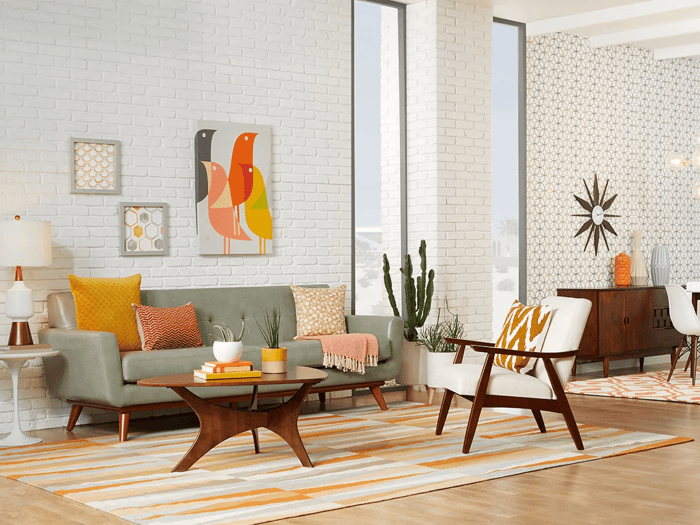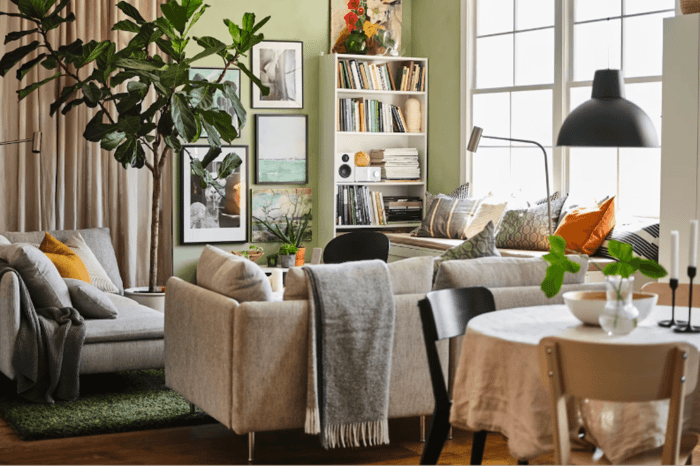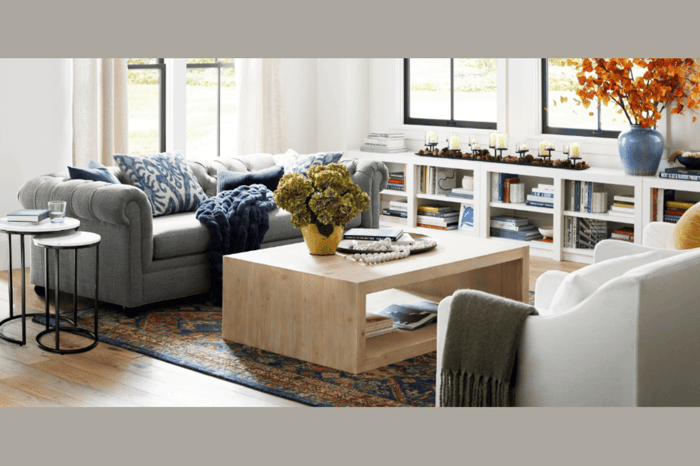HISTORY
What defines the term "Mid-Century Modern" when discussing decor, design and furniture? Its history starts in the middle of the 20th century, roughly between 1930-1965. Sticklers for minute detail would argue that it should only cover the 10 years between 1947-1957. Looking for the roots of this movement, one can see it begins with the Industrial Revolution, but more specifically post-World War I.
The term itself was created by an author in the early 1980’s, who wrote a book about furniture of the 50’s. Cara Greenberg, the author, says she simply invented the term. Her book, ‘Mid- Century Modern: Furniture of the 1950's' was a best-seller and thus the term became a new addition to the American dialect.
INSPIRATION
One could also say the inspiration for this style grew out of the new Modernism movement that took hold after WWII, allowed to blossom because of a boom in prosperity and growing technology. The most influential style that came from other parts of the world was notably the Bauhaus school out of Germany. It was here creators learned to work together, and what emerged was use of clean geometric lines, with an abstract style, eliminating any mawkishness.
Some of the more notable names from that period include designers:
- Charles and Ray Eames
- Harry Bertoia
- Arne Jacobsen
- George Nelson
- Florence Knoll
- Eero Saarine

A Classic Arne Jaconbsen “Egg Chair” collection
The key characteristics of mid-century modern furnishings are clean lines, low profiles, and tapered legs. There was also a combining of natural and man-made materials with everything from wood to lucite being used to produce innovative pieces. The highly ornamented furniture of the past was stripped away, and the new focus of beauty came from the simple pleasing shapes of the pieces themselves.
REINVENTION
It was in the 80’s that the lust for furniture of that time period came back into style. What’s old is always new again as the saying goes. And with the craze at the time towards the Mid-Century Modern style, no could argue that truth. By the early 1990’s collectors and auction houses had driven prices up to outranges amounts as most mid-century furniture designers went out of production.
But manufactures, specifically Knoll, caught on to the trend and changed their business strategy from only serving large corporations and wholesalers or exclusive designers, to the public at large. Herman Miller is another well known manufacturer that hit their stride during this 90’s heyday revitalization. They opened a new branch of the company, Herman Miller For The Home, offering many classic mid-century designs with modern fabrics and materials.

Example of a Herman Miller Mid-Century Modern couch
MEDIA ROLE
It has to also be noted that the media, from magazines, to television, to books, movies, and museums had a part in hyping the mid-century modern craze. The magazine Wallpaper founded in 1996, and then Dwell in 2000 were two strong contenders for pushing the trend. Time magazine dedicated multiple design sections over the years to this fashion.
The Museum of Modern Art had a large role as well, promoting modern design exhibits that afforded visitors an opportunity to sit on the furniture from that era. Even the Library of Congress organized an expansive exhibition devoted to the work of Charles and Ray Eames. Exhibitions of mid-century modern design continue to be popular in museums across the country.
One source of this fad that many may recognize is the highly popular TV services that played for several years called Mad Men, premiering in 2007.
AUTHENTIC
With the never ending desire for this style, most design houses and furniture manufactures have a line of Mid-century modern furniture. Thus how does one distinguish an original from a copy? The folks at a New York based boutique specializing in this era have some words of advice.
“Mid-century furniture functions very well because of its simplicity and fine craftsmanship. But, generally, you can look for the obvious clues such as peg legs or hardware. Another great tip is to search for the country of manufacture—Denmark, Yugoslavia, Japan, Italy, and the U.S. are often authentic mid-century,” offers the owners of Home Union.
CONTINUED POPULARITY
So why is this style still so popular? Most designers will agree, the simple clean lines just simply never go out of fashion. Well designed with a timeless look. Then there is also a hefty nostalgia factor. With close to 72 million baby boomers, the familiarity and comfort with their past continues to hold major sway.
This classic style also focuses on building a strong connection to nature. This is achieved by using furnishings with clean lines, learning toward neutral or warm color tones, understandably resonating with many.
Another reason behind the style’s lasting appeal has to do with how the main concepts have been proven to improve your mood. Large rooms filled with natural light are shown to make people feel happier. A warm color palette can lower stress and increase productivity. The connection to nature, fresh air, taking advantage of large windows artfully placed to frame views to the outside, all-in-all creates a calming feeling.
DECORATING STYLE
The color palette of mid-century started with the bright flavors of the 1950’s, to pastels of the 60’s and finished more earthy tones heading into the 70’s. Overall, designers will advise that neturals never go out of style when to decorate a space in mid-century modern decor. Then one can accessorize with accents of any style creating what is now defined and ‘modern’ mid-century.
Accents, as well as overall design in this style, tend to be minimal. Using plants, rocks, and other nature inspired touches, floor pillows, stylistic candle holders, but remaining clutter-free. Vary furniture or accent heights to break up monotony.

Example of a Mid-Century modern living room.
BEDROOM

DINING ROOM

OUTDOOR

SCANDINAVIAN

HUNTING FOR Mid-Century FINDS
When it comes to decorating, scouring second hand stores, flea markets, auctions, and boutiques will help you find a style that is, instead of being too kitschy, a more sophisticated, elegant, and modern look. You can combine a classic piece with a modern rug for example. The goal is to mix old and new looks that speak of history and the elegant vibe of Mid-Century modern designs.

Here is a perfect mixture of vintage and modern pieces, combined to make an elegant statement room.
Looking at some other design styles that came just before or after Mid-Century Modern gives a comparison and contrasting view into the roots and then progress of different design styles.
MODERN DESIGN
Before Mid-Century modern came what is traditionally known as “Modern”. It is also a predecessor to the contemporary style. This refers to the specific time period from the early to mid-twentieth century. The foundation of modern design coincided with the modern art movement, enlightened by Scandinavian and German design. Focused on using earthly colors, natural material, and a simplicity of form and function.
From modern came mid-century modern covering the 50’s and 60’s.
CONTEMPORARY DESIGN
There is no time period that defines contemporary design. It continues to evolve and reflect the popular styles of present day design; influenced by modernism, minimalism, Art Deco, and other global styles.
SCANDINAVIAN DESIGN
Another style that grew from the mid-century modern movement was the Scandinavian design. It too uses a minimalist look that features soft contours, colorful accents, and a balance of engineered and organic materials. It’s simple, contemporary, and clean, using a majority of the white and grey color palette.
#midcenturymodern #midcentury #vintage #interiordesign #mcm #s #retro #design #homedecor #midcenturyfurniture #architecture #midcenturydesign #vintagefurniture #interior #vintagestyle #midcenturyhome #modernism #midmod #furniture #interiors #decor #midcenturymodernfurniture #midcenturystyle #modern #danishdesign #art #midcenturymodernhome #antiques #midcenturymoderndesign #scandinaviandesign #vintagedecor #interiordesigner #forsale #vintagehome #home #homedesign #interiorstyling #midcenturydecor #vintageshop #furnituredesign #sdesign #teak #shoplocal #midcenturyliving #antique #interiordecor #modernist #moderndesign #stdibs #vintagedesign #spaceage #danishfurniture #decoration #designer #apartmenttherapy #shopsmall #modernart








